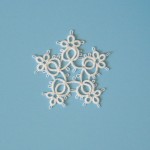For the tatting proficiency pin, it is required that I come up with a glossary. The posted terms are not in any way endorsed by the IOLI, nor is it a complete list of terms used in the tatting world. This is merely my current understanding (which is subject to change), of common terms. (More will be added later.) And these terms will appear in ABC Tatting Patterns. Please note some are listed as common terms only, not with particular abbreviations.
My goal is to make my abbreviations and tatting vernacular as accessible as possible to beginning tatters. At the same time, I would like my patterns to be compatible with other patterns. Therefore, I’m opening this dialogue in hopes of finding a common tatting vernacular.
I invite other tatters to express their own opinions. Please leave a comment or contact me through e-mail by clicking on “Contact Laura” on the sidebar. Thanks! I will get back to you as soon as possible.
May you be blessed; and tat through the rest.
Laura
 Tatting is a very old form of lace making. In ancient Egypt, funeral cloths were trimmed with knotting. (One theory is that tatting developed from knotting.) A combination of rings and chains create various edgings and motifs. The tatting stitch is actually a Lark’s Head knot which is transferred (flipped) along a core thread. This flipped Lark’s Head knot is called a double stitch—the basic stitch used in tatting.
Tatting is a very old form of lace making. In ancient Egypt, funeral cloths were trimmed with knotting. (One theory is that tatting developed from knotting.) A combination of rings and chains create various edgings and motifs. The tatting stitch is actually a Lark’s Head knot which is transferred (flipped) along a core thread. This flipped Lark’s Head knot is called a double stitch—the basic stitch used in tatting.